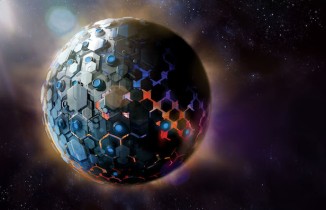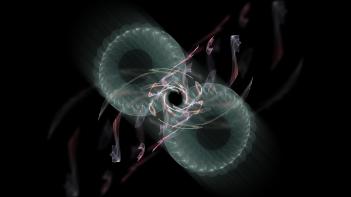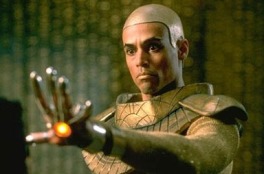Theorists often judge a civilization by its energy demands and access to resources. More advanced a civilization is, bigger the demand for energy gets to feed the population, or to fuel the machines and technology. In 1964 the Russian astrophysicist Nikolai Kardashev suggested a scale for measuring a civilization’s technological advancement based upon how much energy it is able to exploit. This is called the Kardashev Scale.
Not to be mistaken with the Kardashian Index (K-Index) in science which is a measure of discrepancy between a scientist’s social media profile and publication record (influenced by the professional selfie taker Kim Kardasian) 🙂
According to the initial Kardashev scale, there are 3 types of civilizations:
Type I: This civilisation is able to exploit a planet’s entire resources, and control all natural forces of the planet (including volcanoes, earthquakes, etc.) and extract energy from these forces.

The Dyson Sphere around a star. A future technology which could harness power and energy from a star by surrounding it with hexagon shaped satellites.
Type II: is pretty much similar to a Type I civilisation but they have this kind of control over all the planets on their star system. They may have surrounded their star with satelies to harness more energy from it (using some kind of hypothetical magastructure like the Dyson Sphere).
They can feed a stellar mass into a black hole, and collect photons emitted by the accretion disc or capture photons already escaping from the accretion disc, reducing a black hole’s angular momentum; known as the Penrose process.
A civilisation as advanced as Type II could remove a substantial portion of a Star’s matter in a controlled manner for other uses, a hypothetical process called Star lifting. This type of engineering would produce antimatter as an industrial by-product (that could be recycled).

The Penrose process is a process theorised by Roger Penrose wherein energy can be extracted from a rotating black hole.
(http://imgur.com/gallery/zTw9Q)
A Type II civilisation is immune to extinction by anything known to science. They have enough energy to overcome a Malthusian Catastrophe. They are terraformers. They can pulverise a moon sized asteroid if ever its path crosses their stellar system (or move a planet to dodge it entirely). They must also be able to manipulate genes, transplant or replace parts of themselves and may even have a cure for their own mortality.
Type III: The same kind of technology as a Type II civilization but they control an entire galaxy. This is a master race. Completely immortal, they are hundreds of thousands of years’ worth of both biological and mechanical evolution ahead of us. They may surely look very different then us. They can alter molecular bonds and create new materials or even complex forms of new life. They are able to use energy from super-massive black holes, white holes, gamma ray bursts or quasar emissions. They can travel anywhere in the galaxy, build Dyson Spheres around stars and harness energy.
Type IV: Not included in the original Kardashev scale, this civilisation controls the entire resources of a universe. They may even control the mechanisms dominating the universe and slow down entropy or even reverse it.
There’s even Type V, a multiverse civilisation that exploits a collection of universes (after that my imagination hits its limit) or Type VI that live outside time and space and create or destroy universes just as easily (pretty much like a God maybe).
We, as humans are a Type 0 civilisation since we don’t control the resources of our planet in its entirety. To simple creatures like us, any civilisation above Type III (or maybe even them) would seem like immortal, omnipotent deities.
In science fiction we encounter civilisations with immensely advanced technologies. Let’s put them in a Kardashev’s scale 🙂
Star Trek: The Federation of Planets in Star Trek is an example of Type II civilisation while the members of the Q Continuum are clearly Type IV.
 Starwars: The Intergalactic Empire in Starwars is an example of Type III civilisation.They make use of the resources of an entire galaxy, they can form or destroy planets at their will.
Starwars: The Intergalactic Empire in Starwars is an example of Type III civilisation.They make use of the resources of an entire galaxy, they can form or destroy planets at their will.
Stargate: The Goa’uld in Stargate is a strange example for Type III. They tap into the resources of an entire galaxy therefore they might be considered as Type III but for a very mysterious reason they have done nothing in terms of bioengineering and therefore remain a parasitic species. But then again, we are only Type 0 so we cannot really understand their judgement, right? 😉
Cthulhu Mythos: I think that the great race of Yith is actually a Type III civilisation. their ability to project their minds into different planets and inside other species makes them immortal.
The Great Old Ones like Cthulhu are Type IV and the Elder Gods (like Hopnos, Nodens, Bastet) might actually be a Type V or above (except that they are very evil).
So a devoted and wise acolyte might actually say that Azathoth is not in the universe. The universe is in Azathoth 🙂





Nice post…
LikeLiked by 1 person
thanks! 😀
LikeLike
You are welcome 🙂
LikeLiked by 1 person
It’s lovely to see that you’re writing about things apart from the book you’re working on ! It makes for a refreshing break and at the same time an extremely interesting read 😀
LikeLiked by 1 person
Thank you so much 🙂
LikeLiked by 1 person
Awesome!
LikeLiked by 1 person
Thanks 😀
LikeLike